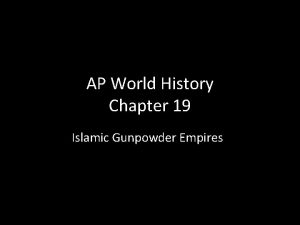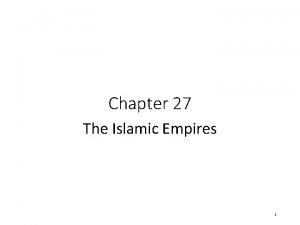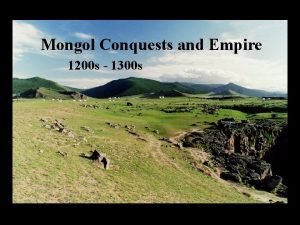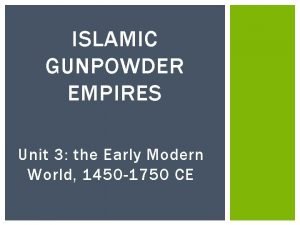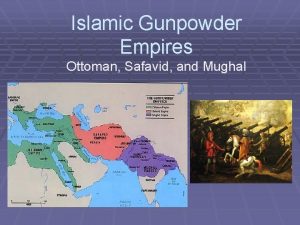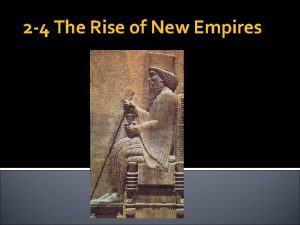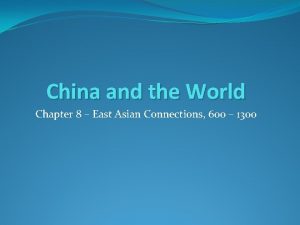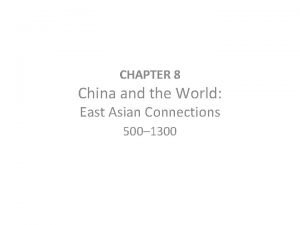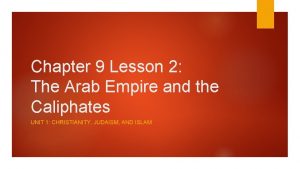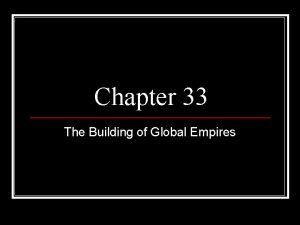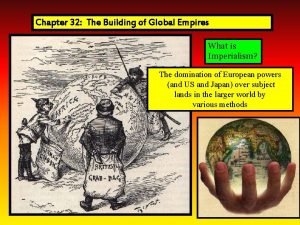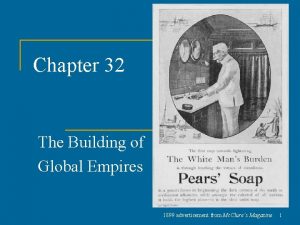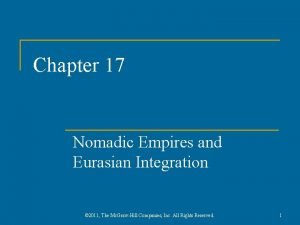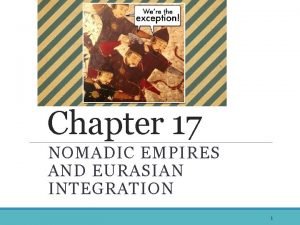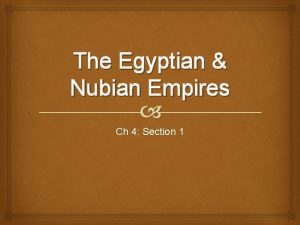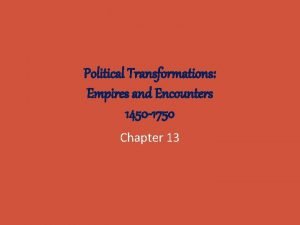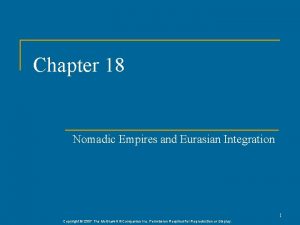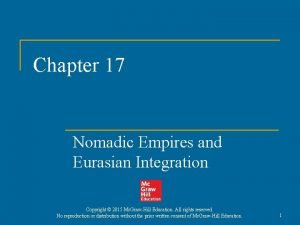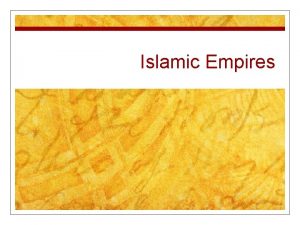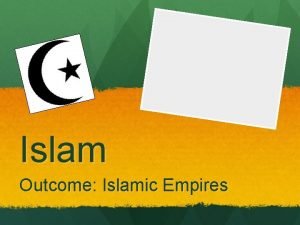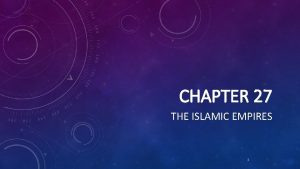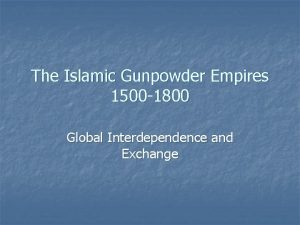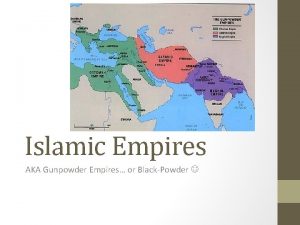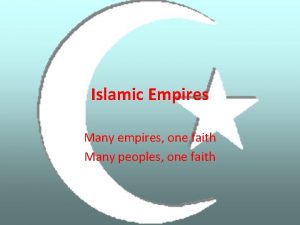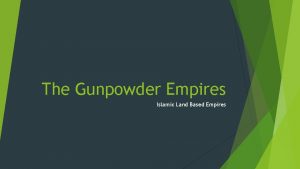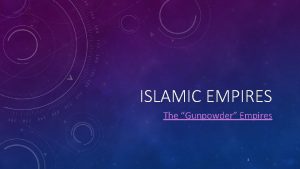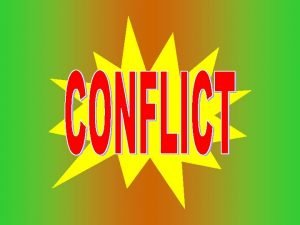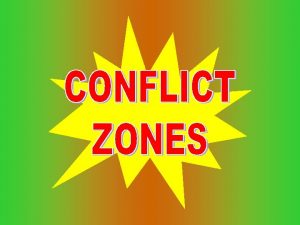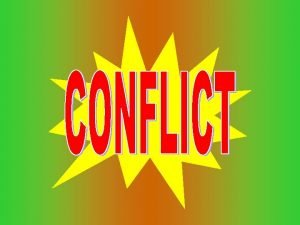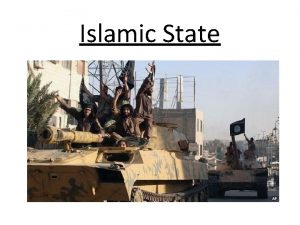Chapter 17 New Asian Empires Islamic Empires 1500



















- Slides: 19

Chapter 17: New Asian Empires

Islamic Empires – 1500 -1800 CE

The Ottoman Empire (1289 -1923) n Osman leads bands of semi-nomadic Turks to become ghazi (Muslim religious warriors) Captures Anatolia (Asia Minor) with light cavalry and volunteer infantry n In Balkans, forced Christian families to surrender young boys to military service n n Became exceptional Janissaries n Mehmed II (the Conqueror) r. 1451 -1481 CE n Renamed Constantinople, Istanbul n Suleyman the Magnificent (r. 1520 -1566 CE) n Expanded into Asia and Europe n Developed a naval power

The Safavid Empire n Empire called Safavid, after Safi al-Din (1252 -1334) n Ismail young military leader, r. 1501 -1524 n Orphaned, parents killed by enemies n Proclaims official religion of realm Twelver Shiism n n n Twelve infallible imams after Muhammad 12 th imam in hiding, ready to take power Wore distinctive red hat n ‘Abbas (1588) greatest of Shahs n Strengthened the military – use of gunpowder n Enslaved Russian youth to be trained fighters

The Mughal Empire n Zahir al-Din Muhammad (Babur), invades northern India for plunder, 1523 Gunpowder technology gives Babur advantage n Founds Mughal (Persian for Mongol) dynasty n Expands through most of Indian subcontinent n n Akbar (r. 1556 -1605): Grandson of Babur n Created centralized government n Destroyed Hindu kingdom of Vijayanagar n Religiously tolerant, promoted debate between differing religions (especially Muslims and Hindus)

Other Mughal Emperors/Shahs n Jahangir (Akbar’s son) n Rebelled against and reconciled with Akbar n Fought against Sikhs (blend of Hindu & Islam) n Shah Jahan: son of Jahangir n Built the Taj Mahal (tomb for his wife) n New Capital at Dehli (heavily taxed people) n Aurangzeb: son of Jahan n Expands Mughal empire into southern India n Hostile to Hinduism n n Demolished Hindu temples, replaced with mosques Tax on Hindus to encourage conversion

Religious Diversity of Islamic Empires n Ottoman Empire: Christians, Jews n Safavid Empire: Zoroastrians, Jews, Christians n Mughal Empire: Hindus, Jains, Zoroastrians, Christians, Sikhs n Mughal Akbar most tolerant Received Jesuits politely, but resented Christian exclusivity n Enthusiastic about syncretic Sikhism, self-serving “Divine Faith” n

The Ming and Qing Dynasties

The Ming Dynasty (1368 -1644) n Ming (“Brilliant”) dynasty comes to power after Mongol Yuan dynasty driven out n Founded by Emperor Hongwu (r. 1368 -1398) n Used traveling officials called Mandarins and large number of eunuchs to maintain control n Emperor Yongle (r. 1403 -1424) experiments with sea expeditions, moves capital north to Beijing to deter Mongol attacks n Ming emperors encourage abandonment of Mongol names, dress n n Support study of Confucian classics Civil service examinations renewed

The Great Wall of China n Origins before 4 th century BCE, ruins from Qin dynasty in 3 rd century BCE n Rebuilt under Ming rule, 15 th-16 th centuries n n 1, 550 miles, 33 -49 feet high Guard towers; Room for housing soldiers

Ming Decline and Collapse n Decline n 16 th century maritime pirates harm coastal trade n Navy, government unable to respond effectively n Emperors secluded in Forbidden City, palace compound in Beijing n Emperor Wanli (r. 1572 -1620) abandons imperial activity to eunuchs n Collapse n Rebels take Beijing in 1644 n Manchu fighters enter from the north and retake city n Manchus refuse to allow reestablishment of Ming

The Qing Dynasty (1644 -1911) n Manchus originally pastoral nomads, north of Great Wall n Chieftain Nurhaci (r. 1616 -1626) unifies tribes into state, develops laws, military n Establishes control over Korea, Mongolia, China War with Ming loyalists to 1680 n Support from many Chinese, fed up with Ming corruption n n Manchus forbid intermarriage, study of Manchu language by Chinese, force Manchu hairstyles as sign of loyalty

Qing Emperors n Kangxi (r. 1661 -1722) n n Confucian scholar, poet Military conquests: island of Taiwan, Tibet, central Asia n Emperor Qianlong (r. 1736 -1795) n n n Expands territory Height of Qing dynasty Great prosperity, tax collection cancelled on several occasions n “Son of Heaven” – quasi-divine emperors n n Hundreds of concubines; thousands of eunuchs Clothing designs and name characters forbidden to the rest of the population

Qing Culture n Scholar bureaucrats n Intense Civil Service Exams – open to anyone (men) n Confucian classics, calligraphy, history n Three-days of uninterrupted examinations n Literacy Rates improved n Opportunity for greater social mobility n Family and Gender Relations n Filial Piety was understood as child’s duty n Eldest son was honored above the rest n Footbinding was aesthetic and class based

Chinese Trade during Ming and Qing n Was once one of the greatest in the world n Stagnated during the 16 th to 20 th century n Government placed restrictions on technological advancements – fear of social instability n Maintained trade in SE Asia and some w/ the Dutch n Imported very little – was paid with silver from Americas n Exports included: silk, porcelain, tea, spices

Neo-Confucianism and Christianity n Neo-Confucianism: version of Confucian thought promoted by Zhu Xi (1130 -1200 CE) n n Confucian morality with Buddhist logic Education at various levels promoted n Christianity n Nestorians and Roman Catholics had a presence, but were never exclusive n Jesuit, Matteo Ricci, attempted to convert Emperor Wanli – brought some western technology

Medieval Japan and Korea

Japan’s Warrior Society n 12 th c. CE – government had lost power - local clans began to fight for control n Shoguns rule Japan, 12 th-16 th centuries n n n Large landholders with private armies (samurai) Emperor merely a figurehead Constant civil war: 16 th century sengoku, “country at war” n Control of Daimyo (Great Names) n Approx. 260 independent territorial lords n Shogun requires leaders alt. attendance (every other year) n Beginning 1630 s, shoguns restrict foreign relations

Tokugawa Shogunate n Tokugawa Ieyasu (r. 1600 -1616) est. military govt. n Bakufu: “tent government” – pyramid hierarchy n Establishes Tokugawa dynasty (1600 -1867) n Relations with the West n Increased trade with Europeans (esp. Portuguese) n By 1650 allowed only trade with the Dutch n Feudal Culture n Haiku poetry – 3 lines, 17 syllables n Kabuki drama – could last all day (stylized dance & song)
 Chapter 19 islamic gunpowder empires
Chapter 19 islamic gunpowder empires Chapter 27 the islamic empires
Chapter 27 the islamic empires Chapter 27 the islamic empires
Chapter 27 the islamic empires Islamic gunpowder empires webquest
Islamic gunpowder empires webquest Islamic gunpowder empires
Islamic gunpowder empires Impaler state of decay 2
Impaler state of decay 2 Land empires
Land empires The rise of new empires
The rise of new empires Chapter 8 china and the world east asian connections
Chapter 8 china and the world east asian connections Chapter 8 china and the world east asian connections
Chapter 8 china and the world east asian connections Lesson 2 the arab empire and the caliphates
Lesson 2 the arab empire and the caliphates Chapter 33 the building of global empires
Chapter 33 the building of global empires Chapter 32 the building of global empires
Chapter 32 the building of global empires Chapter 32 the building of global empires
Chapter 32 the building of global empires Chapter 17 nomadic empires and eurasian integration
Chapter 17 nomadic empires and eurasian integration Chapter 17 nomadic empires and eurasian integration
Chapter 17 nomadic empires and eurasian integration Chapter 4 section 1 the egyptian and nubian empires
Chapter 4 section 1 the egyptian and nubian empires Chapter 5 political transformations empires and encounters
Chapter 5 political transformations empires and encounters Chapter 18 nomadic empires and eurasian integration
Chapter 18 nomadic empires and eurasian integration Chapter 17 nomadic empires and eurasian integration
Chapter 17 nomadic empires and eurasian integration
